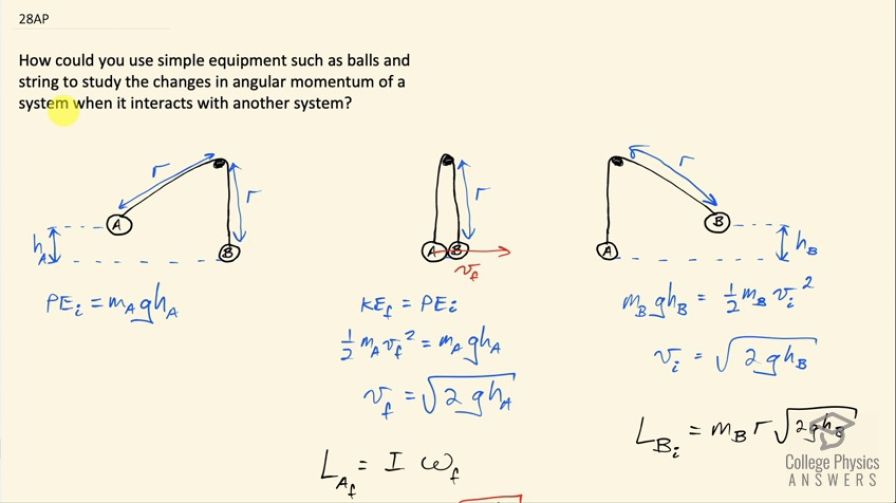Question
How could you use simple equipment such as balls and string to study the changes in angular momentum of a system when it interacts with another system?
Final Answer
Please see the solution video.
Solution video
OpenStax College Physics for AP® Courses, Chapter 10, Problem 28 (Test Prep for AP® Courses)

vote with a rating of
votes with an average rating of
.
Video Transcript
This is College Physics Answers with Shaun Dychko. We are meant to use some simple equipment such as balls and some string to study changes in angular momentum of a system when it interacts with another system so we need to have at least two balls so that we have two different things each representing a different system and we'll have to make them interact. So suppose we use some string to suspend the balls from an equal radius from some pivot up here and we could raise ball A to some height h A in which case, it will have some potential energy equal to its mass times gravitational field strength times the height and we'll need to measure the mass of both these balls by the way as part of our procedure in this experiment and then when mass A is dropped, it will achieve some final velocity just before collision with mass B here at which point, its kinetic energy will be equal to the potential energy that it had initially and so one-half m A times its final speed squared at the bottom of its arc equals mass A times g times h A initially and we can solve this for v f and say it's square root of 2gh A. And so this has to do with angular momentum because we can say that the angular momentum of ball A is its moment of inertia multiplied by its angular speed and its angular speed will be this linear speed divided by its radius of travel so square root 2gh A divided by r is the final angular speed of ball A. Then we multiply by its moment of inertia which since it's a point mass is its mass times the radius that it's traveling in squared, one of these r's cancel and we are left with m Ar times square root 2gh A. So that's the angular momentum of ball A just before collision with ball B. And to see how that transfers to ball B, we can then look at ball B and see what is the maximum height that it reaches after it's propelled by this collision with ball A and its final potential energy will equal the initial kinetic energy that it had here and we want to know what that initial kinetic energy is because we can then solve for its speed and then knowing its speed, we can find its angular momentum after the collision just the same as we did for ball A and it will be mass B times its radius times square root 2g and multiply by h B—its maximum height after collision. So we should compare the angular momentum of ball B after the collision with the angular momentum of ball A before the collision and we'll find that they should be the same and we could vary the masses and the initial height of ball A and the radius of travel to see what effect that has on angular momentum transfer.